

Three librarians share how flipped teaching is crucial for student engagement and the future of education. Through the use of innovative technologies and online resources, school libraries can now be available to students wherever—and whenever—they need them.

“Flipped” or blended learning offers students the power of personalized instruction, through a mix of virtual and face-to-face interactions, at a student’s own pace. Embracing this concept is a must for student engagement and the future of the profession, say school librarians Joyce Valenza, Brenda Boyer, and Michelle Luhtala. School Library Journal discusses the benefits of flipping the classroom.
School libraries need a revolution, not evolution One of the biggest business battles of our time is between Microsoft and Google.
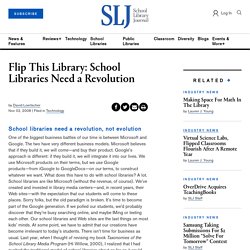
The two have very different business models. Microsoft believes that if they build it, we will come—and buy their product. Google’s approach is different: if they build it, we will integrate it into our lives. We use Microsoft products on their terms, but we use Google products—from iGoogle to GoogleDocs—on our terms, to construct whatever we want. Sheryl Woods helps walk educators how to create a flipped classroom. Michigan State University share what, why, and wow to implement a flipped classroom.
What is a flipped classroom?
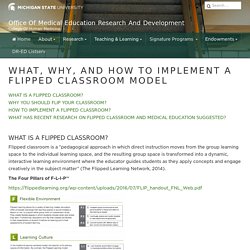
Why you should flip your classroom? How to implement a flipped classroom? Hot Tips for Hacking the Flipped Classroom is a podcast from Aaron Sams where he shares his tips for flipping your classroom. Mary Beth Hertz share Pros and Cons in a Flipped Classroom. What It Is According to the description on ASCD's page for the newly released book, Flip Your Classroom: Reach Every Student in Every Class Every Day, by flipped-classroom pioneers Aaron Sams and Jonathan Bergmann, "In this model of instruction, students watch recorded lectures for homework and complete their assignments, labs, and tests in class.
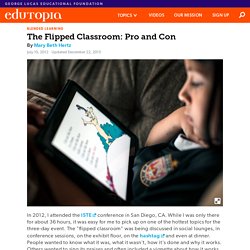
" In part one of a three-part series of articles, Bergmann, along with two co-authors, tries to dispel some of the myths surrounding the flipped classroom. Research on flipping the classroom in higher education. Teaching at the university level has been performed in a relatively similar manner during a long historical time and across cultures.
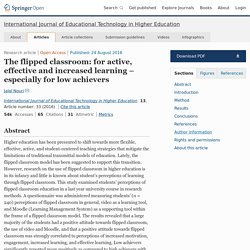
As a central pillar, we find the traditional lecture with the professor, or the “sage on the stage” as put by King (1993), transmitting knowledge to receiving students. Nevertheless, over the past 30 years, university education and traditional lectures in particular have been strongly criticized. The main criticism has cast light on the following: students are passive in traditional lectures due to the lack of mechanisms that ensure intellectual engagement with the material, student’s attention wanes quickly, the pace of the lectures is not adapted to all learners needs and traditional lectures are not suited for teaching higher order skills such such as application and analysis (Cashin, 1985; Bonwell, 1996; Huxham, 2005; Young, Robinson, & Alberts, 2009).
This research is a critical review of the flipped classroom. Flipped classroom approach has become a popular pedagogy in many education institutes around the world.

The basic notion of flipped classroom approach is to deliver the teacher’s lectures before class through online videos, in order to free-up the in-class time for active learning and problem solving activities. The use of flipped classroom approach has been extensively studied, especially in the contexts of higher education. When compared the learning outcomes with traditional teaching, the previous reviews suggest that flipped classroom approach can improve student performance or at worst do no harm to student learning. Barbi Honeycutt, Ph.D. explains what the flipped classroom is.
When people see the name of my business (FLIP It Consulting), they usually ask, “What is ‘flip’ it?”

Before I can explain, they start asking questions to see if they can guess. “Do you flip houses?” Olga Bedrina explains why and how to use a flipped classroom. According to the U.S.
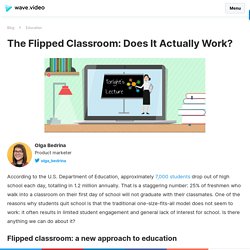
Department of Education, approximately 7,000 students drop out of high school each day, totalling in 1.2 million annually. That is a staggering number: 25% of freshmen who walk into a classroom on their first day of school will not graduate with their classmates. One of the reasons why students quit school is that the traditional one-size-fits-all model does not seem to work: it often results in limited student engagement and general lack of interest for school. Is there anything we can do about it? Flipped classroom: a new approach to education. Jill Hobbs says How to Start Your Flipped Classroom and gives useful tools.
Edpuzzle shares how to use Edpuzzle to begin a flipped classroom. You might have stumbled across the flipped classroom by way of professional development or in one of your college education courses.

If you’re a bright and shiny new teacher, maybe you’ve even experienced the flipped classroom for yourself. But as the case often is, it’s one thing to study theory, and it’s quite another to put it into practice. That’s why the key to successfully flipping your classroom is finding resources that make your life easier. Before getting into the nitty-gritty of setting up your first flipped class, let’s get on the same page about what we’re talking about when we say flipped classroom, and how it came to be the educational juggernaut that it is today. Planbook shares advice and information from teachers that have flipped their classrooms.
Today’s teachers and administrators are faced with constant pressure to meet state and federal standards.
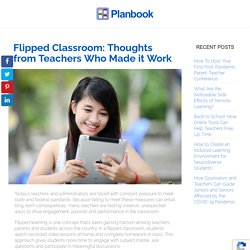
Because failing to meet these measures can entail long-term consequences, many teachers are testing creative, unexpected ways to drive engagement, passion and performance in the classroom. Flipped learning is one concept that’s been gaining traction among teachers, parents and students across the country. Lucie Renard shares how to flip a classroom and 20 apps for flipped learning. This digital age makes it more and more possible to flip the classroom. Today, almost 50% of households worldwide own a computer, not to mention any other devices like Smartphones. There are 4 388 million active internet users. Depending on what possibilities your students have at home, you can easily go with the flow and embrace creating a digital classroom. Especially when it comes to flipping the classroom. Matthew Lynch shares a list of 86 Flipped Classroom Apps, Tools & Resources. The traditional model of teachers lecturing in the classroom and students completing practice and homework on their own is changing.
Instead, students are learning on their own and using the classroom as a place to dig more deeply into what they’ve learned. This model, known as the flipped classroom, is gaining popularity thanks to the rise of EdTech.